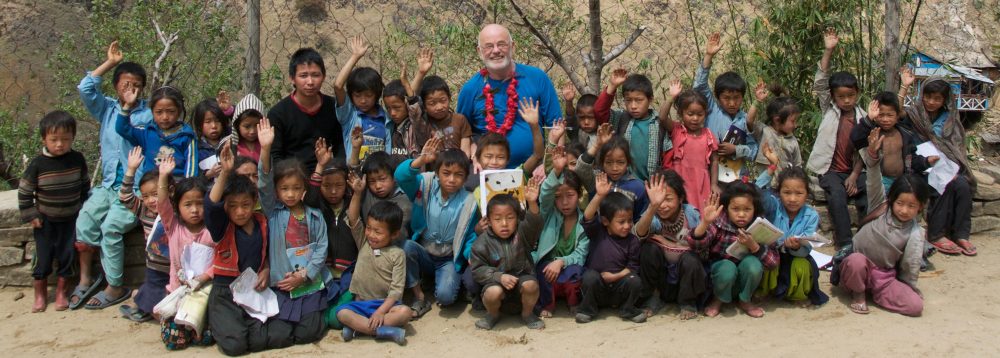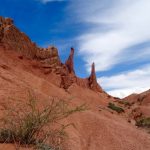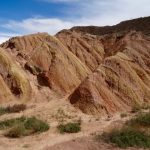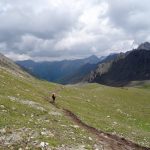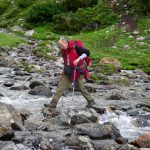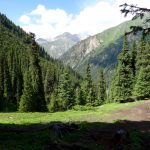After a fairly arduous and uncomfortable second flight where they brought us dinner at 3.00 in the morning, we arrived in Bishkek. The process of passing through the airport took less than fifteen minutes, which is pretty remarkable.
Alex was there to meet us and escort us out of the air conditioned airport into the wall of heat outside. The Mercury was touching 38C.
The journey from the airport to Bishkek takes about forty minutes passing flat fields of farmland on either side. What could hardly be seen was the wall of snow capped mountains to the south, indistinct through the heat haze.
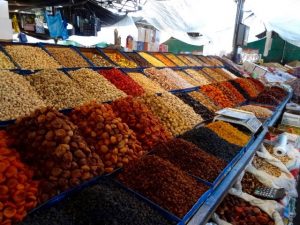 Having checked into Asia Mountains Hotel 1, breakfasted and rested briefly, we met up with Alex for a briefing where he took us through some of the logistics of the trip. Then we ventured out into town, first to visit a market. There we were tempted by the nuts and dried fruits, which were nothing like the ones we buy at home. I’m not particularly fond of apricots but the ones I tried were delicious, so much so I bought 1/2 a kilo and a similar weight of cashew nuts. The women running these stalls were very friendly, as you would expect, and allowed us to taste samples. Broad beans, dried and salted were particularly moorish. Sandie bought some of those.
Having checked into Asia Mountains Hotel 1, breakfasted and rested briefly, we met up with Alex for a briefing where he took us through some of the logistics of the trip. Then we ventured out into town, first to visit a market. There we were tempted by the nuts and dried fruits, which were nothing like the ones we buy at home. I’m not particularly fond of apricots but the ones I tried were delicious, so much so I bought 1/2 a kilo and a similar weight of cashew nuts. The women running these stalls were very friendly, as you would expect, and allowed us to taste samples. Broad beans, dried and salted were particularly moorish. Sandie bought some of those.
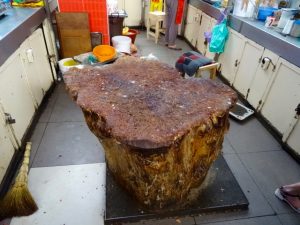 Continuing through the market we found ourselves in the meet section, which turned out not to be as gruesome as I thought. I have seen much worse. The only thing I found slightly off putting was the pervading odour of raw flesh. The most fascinating thing we saw were the chopping blocks which were made out of sections of tree trunk, hollowed and pitted from years of use. It was the only thing I saw which made me question hygiene; how do you make sure that it is clean from one day to the next?
Continuing through the market we found ourselves in the meet section, which turned out not to be as gruesome as I thought. I have seen much worse. The only thing I found slightly off putting was the pervading odour of raw flesh. The most fascinating thing we saw were the chopping blocks which were made out of sections of tree trunk, hollowed and pitted from years of use. It was the only thing I saw which made me question hygiene; how do you make sure that it is clean from one day to the next?
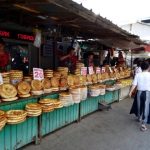
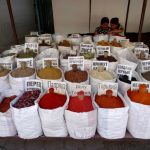
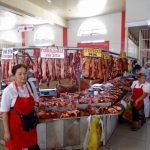 The meat was concentrated into halls, one of which was dedicated solely to horse meat. I found the offal a bit off putting.
The meat was concentrated into halls, one of which was dedicated solely to horse meat. I found the offal a bit off putting.
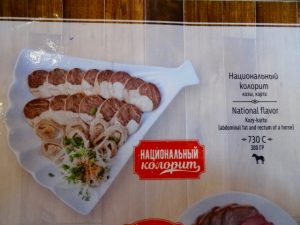 Leaving the market behind, we headed off to a restaurant for lunch. It was, by now, gone three in the afternoon but as our body clocks were out of sync it really did not matter. The menu was a picture book with brief written descriptions to help you choose. I decided to play safe and go for a tomato and onion salad and a chicken Caesar salad. I had forgotten about the use of fennel with everything. It does enhance a meal. All very secure and not brave at all when you consider I could have had horse rectum! The two pints of Arpa beer also went down very well.
Leaving the market behind, we headed off to a restaurant for lunch. It was, by now, gone three in the afternoon but as our body clocks were out of sync it really did not matter. The menu was a picture book with brief written descriptions to help you choose. I decided to play safe and go for a tomato and onion salad and a chicken Caesar salad. I had forgotten about the use of fennel with everything. It does enhance a meal. All very secure and not brave at all when you consider I could have had horse rectum! The two pints of Arpa beer also went down very well.
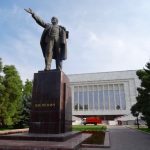
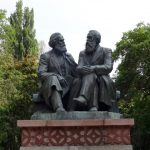 The contrast between the air-conditioned comfort of the restaurant and the outside world was phenomenal as we went for a brief walk around the heart of the city, sticking as much as we could to the avenues of trees shading us from the fierce sun. We took in various statues of Lenin, Engels and Marx. The more I experience of this city, the more I like it. I think there have been noticeable improvements since my first visit in 2012.
The contrast between the air-conditioned comfort of the restaurant and the outside world was phenomenal as we went for a brief walk around the heart of the city, sticking as much as we could to the avenues of trees shading us from the fierce sun. We took in various statues of Lenin, Engels and Marx. The more I experience of this city, the more I like it. I think there have been noticeable improvements since my first visit in 2012.
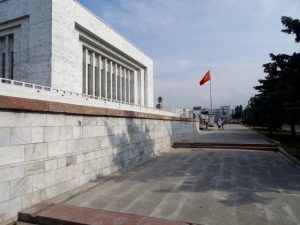 Bishkek is an incredibly green city with huge swathes of woodland offering respite from the summer heat. They also give shelter in the extremely cold winters. It is a colourful city with huge flower beds full of brightly coloured floral displays. It is so colourful because it is all fed by a simple series of irrigation channels bringing water from the mountains to the south. This colour helps also to break up the monolithic austerity of some of the Soviet era buildings. In amongst the trees are fairground rides for children and others with a daring disposition.
Bishkek is an incredibly green city with huge swathes of woodland offering respite from the summer heat. They also give shelter in the extremely cold winters. It is a colourful city with huge flower beds full of brightly coloured floral displays. It is so colourful because it is all fed by a simple series of irrigation channels bringing water from the mountains to the south. This colour helps also to break up the monolithic austerity of some of the Soviet era buildings. In amongst the trees are fairground rides for children and others with a daring disposition.
Back at the hotel there was just time for some kit sorting, another nap, before dinner at 8.00. Nobody was really that hungry, having had such a late lunch but, as it was delicious, we ate it all. Soon after, bed called for a much deserved and needed night’s sleep.
Leaving Bishkek, we headed east along the highway that runs parallel to the border with Kazakhstan, and, for 800m, entered it. All the time there was a chain of snow capped mountains to the south. After some distance we turned south and began to climb into the mountains, stopping for lunch ridiculously early at 11.00am. Despite not feeling particularly hungry, I ate it all.
We had noticed so far during the journey that Mike had been taking lots of pictures through the window of the minibus. It was difficult, if not impossible, to take them without telegraph poles in the foreground. Some of the backgrounds, which we assumed were the main subject of his pictures, were a little hazy and indistinct in the heat haze. Then we realised that Mike was probably, actually photographing the poles. We began to believe that he, having kept it secret from us for so long, was a world renowned expert on telegraph poles and he was gathering evidence for his much anticipated book, ‘Telegraph Poles of the World’! This was confirmed when we caught him photographing trees in order to assess their telegraph pole potential!
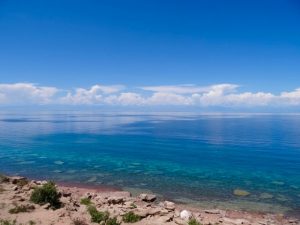 We eventually reached Lake Issy Kul, the second largest mountain lake in the world, behind Lake Titicaca. It is 178km long, 50km wide and over 600m deep at its deepest point. Half a dozen rivers flow into the lake but none flow out, making its waters slightly saline.
We eventually reached Lake Issy Kul, the second largest mountain lake in the world, behind Lake Titicaca. It is 178km long, 50km wide and over 600m deep at its deepest point. Half a dozen rivers flow into the lake but none flow out, making its waters slightly saline.
Following the southern shore we came across numerous resorts, many of which looked as if they were work in progress. Local holiday makers were enjoying the hot sunshine and the cooling waters but it was noticeable that it was mainly men and children who were in the water.
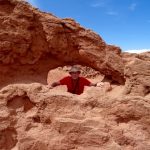 At one point we stopped to visit the fairy canyon, a feature of red, orange and yellow rock thrust up vertically into the air. Its exposure to wind and rain has created a number of interesting shapes that cannot help but inspire your imagination.
At one point we stopped to visit the fairy canyon, a feature of red, orange and yellow rock thrust up vertically into the air. Its exposure to wind and rain has created a number of interesting shapes that cannot help but inspire your imagination.
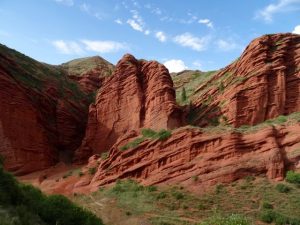 Soon before we reached the end of the lake we turned south into the Jety-Oguz Gorge. This was a narrowing Valley with red rock on either side and pine forested mountains. Down the middle of it rushed a mountain river of snow meltwater. Stopping by a particularly impressive wall of red rock, illuminated brilliantly by the sun, we climbed up to a view point to see them much better. These rocky outcrops were he Seven Bulls.
Soon before we reached the end of the lake we turned south into the Jety-Oguz Gorge. This was a narrowing Valley with red rock on either side and pine forested mountains. Down the middle of it rushed a mountain river of snow meltwater. Stopping by a particularly impressive wall of red rock, illuminated brilliantly by the sun, we climbed up to a view point to see them much better. These rocky outcrops were he Seven Bulls.
While we were there we were spotted by the local entrepreneurs who came running towards us, each with an eagle on their hand. As they ran the eagle spread their wings for balance. They were beautiful creatures, not hooded so they were aware of us all the time. The request was 600 Son for a photo. None of us were inspired to part with cash, not wishing to condone such treatment of such stunning birds. £7 was a hugely inflated price when fuel is less than 50p/litre and a pint of beer £1.
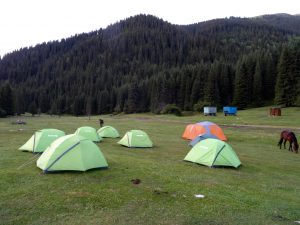 A few miles up the gorge we reached our campsite. The sky had been darkening all the time we were travelling up the gorge. Lightning and thunder tumbled around the mountain tops. As we started to put up our tents the rain started and for a while it was a little unpleasant. A strong wind accompanied the rain, trying to rip the tents from our grasp before we could secure them to the ground. Fortunately it did not last long and we were able to make ourselves relatively comfortable.
A few miles up the gorge we reached our campsite. The sky had been darkening all the time we were travelling up the gorge. Lightning and thunder tumbled around the mountain tops. As we started to put up our tents the rain started and for a while it was a little unpleasant. A strong wind accompanied the rain, trying to rip the tents from our grasp before we could secure them to the ground. Fortunately it did not last long and we were able to make ourselves relatively comfortable.
In the evening we huddled around a floor cloth of food in the mess tent. Soon afterwards we all retired to our tents for an early night and were tucked up easily by 9.00pm. I woke at midnight feeling I had had a good night’s sleep and struggled to go off again. The rushing river nearby did not help.
I was up quite early in the morning and ready for the off. A lot of our attention had been spent on reducing the weight of our kit for this section of the trip. This was our last chance to offload kit we didn’t need to be kept safe in the minibus. Out target was to get it down to 7-8kg. Not easy when you are used to taking the kitchen sink. After many attempts we managed to whittle our kit down to the right specifications so that our porters did not have too much to carry in addition to all the kitchen equipment and tents.
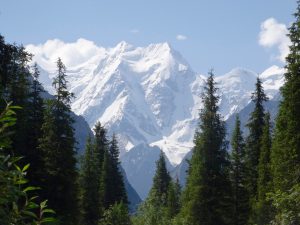 We left camp at 8.15 and headed up the Djety-Oguz Gorge. It was beautiful alpine scenery with rocky sides to the valley inhabited by very tall, narrow pines. As we climbed the head of the valley appeared, a wall of white mountain. There ahead of us was Karakol Peak 5218m, the highest peak in the region. Glaciers tumbled down its precipitous faces.
We left camp at 8.15 and headed up the Djety-Oguz Gorge. It was beautiful alpine scenery with rocky sides to the valley inhabited by very tall, narrow pines. As we climbed the head of the valley appeared, a wall of white mountain. There ahead of us was Karakol Peak 5218m, the highest peak in the region. Glaciers tumbled down its precipitous faces.
After about 6km we turned into a side valley that narrowed as we climbed gently up it. As we turned a corner another wall of rock and ice greeted us at the head of the valley. This was a series of unarmed peaks a little over 4000m. We were going to camp beneath this impressive wall at the foot of the Telety Pass.
Shortly after an early lunch the skies darkened again, the thunder tumbled and this was soon followed by rain and hail. Fortunately we were prepared for it, seeing it before it arrived. It did mean that the rest of the walk into camp was less enjoyable but by the time we arrived at 1.30, the rain had eased and the warm sun that followed soon dried anything that was wet.
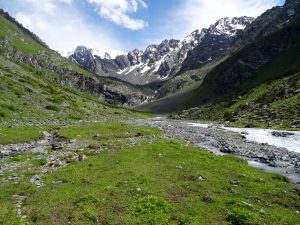 What to do for the rest of the day? Simon and I went to explore the head of the valley where a waterfall and cascade descended adjacent to each other over the head wall from the ice and snow above.
What to do for the rest of the day? Simon and I went to explore the head of the valley where a waterfall and cascade descended adjacent to each other over the head wall from the ice and snow above.
I began to feel that over recent years we have lost some of the exploratory elements of my trips. It was great to be on a journey, camping wild among the mountains and having both the time and the energy to explore off the beaten track. This was great and the fact we caught sight of a couple of marmots was a bonus.
A couple of concerns niggled at the back of my mind. Chris was not travelling very well and as this was the easiest of the four days, it worried me. I carried her rucksack for part of the journey but she seemed to be struggling with her breathing. It doesn’t help that she also had a slight stomach problem. Sandie, who came out with a tweaked knee, has tweaked it again. She has some pain and it has swollen up. My worry is that it is a 750m steep climb up to the Telety Pass tomorrow, followed by a 1000m descent. Still, we have all day.
The Telety Pass proved quite taxing. Chris was feeling better when she woke up, so decided she was able to give it a go. I insisted on carrying her rucksack, as well as my own, in order to give her a better chance.
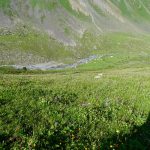
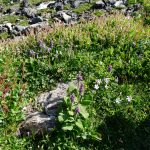
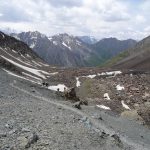 Fortified with semolina and raisins for breakfast, we set off at about 8.15. We immediately started the climb from camp up to the first shoulder. Chris and I started at the back, knowing we were going to be slow. Despite our slowness it was rewarding to look down on camp and see what we had achieved in a relatively short time. From the shoulder the gradient lessened and we were walking through the most perfect alpine meadow with a colourful display of blues, purples, yellows, oranges and whites. Included in the whites was the eidlweis.
Fortified with semolina and raisins for breakfast, we set off at about 8.15. We immediately started the climb from camp up to the first shoulder. Chris and I started at the back, knowing we were going to be slow. Despite our slowness it was rewarding to look down on camp and see what we had achieved in a relatively short time. From the shoulder the gradient lessened and we were walking through the most perfect alpine meadow with a colourful display of blues, purples, yellows, oranges and whites. Included in the whites was the eidlweis.
Crossing the river there was another steep section that took us to another shoulder that led into a rocky bowl with a final steep section up to the pass. By the time we had reached the bowl we had left the flowers behind and kept coming upon pockets of snow.
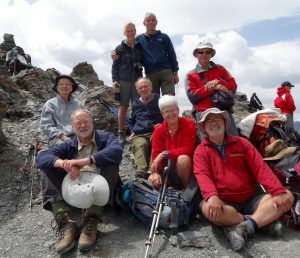 It took Chris and me three and a half hours to climb the 800m to the top of the Telety Pass, not that far behind most of the group. For Chris it was a great achievement and she found the last quarter really tiring as the semolina effect was wearing off. Nothing makes me happier than enabling somebody to achieve something they thought was beyond their reach, and if carrying a second rucksack gives them a better chance I am happy to do so. Terry’s reaction when Chris arrived at the Pass was priceless,”Oh, hello darling. You made it then? Well done.”
It took Chris and me three and a half hours to climb the 800m to the top of the Telety Pass, not that far behind most of the group. For Chris it was a great achievement and she found the last quarter really tiring as the semolina effect was wearing off. Nothing makes me happier than enabling somebody to achieve something they thought was beyond their reach, and if carrying a second rucksack gives them a better chance I am happy to do so. Terry’s reaction when Chris arrived at the Pass was priceless,”Oh, hello darling. You made it then? Well done.”
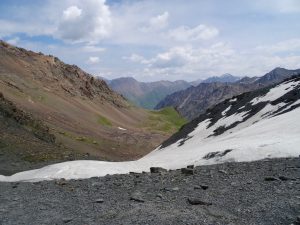 If we thought the ascent was difficult, the descent was doubly so. It was a much greater distance than the ascent and it was also a drop of 1000m. It took us on steep terrain, across snowfields and, most difficult of all, boulder fields that seemed to go on for ever. Alexander was getting visibly frustrated with the lack of speed. He showed a lack of understanding and patience. Not only was Chris struggling with the unfamiliar territory but Sandie was concentrating on protecting her knee, while Simon developed a headache and felt sick. After all, this was only our second day of walking and we had reached 3759m, that is well over 12,000 feet. The descent into camp took five and a half hours.
If we thought the ascent was difficult, the descent was doubly so. It was a much greater distance than the ascent and it was also a drop of 1000m. It took us on steep terrain, across snowfields and, most difficult of all, boulder fields that seemed to go on for ever. Alexander was getting visibly frustrated with the lack of speed. He showed a lack of understanding and patience. Not only was Chris struggling with the unfamiliar territory but Sandie was concentrating on protecting her knee, while Simon developed a headache and felt sick. After all, this was only our second day of walking and we had reached 3759m, that is well over 12,000 feet. The descent into camp took five and a half hours.
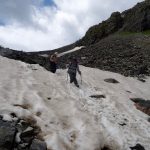
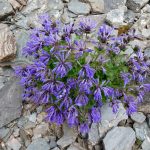
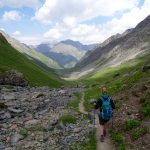 However, once settled in camp, there was some doubt as to whether Chris should attempt the walk the next day as it involves a steep 1200m ascent. After some discussion it seemed as though Chris had no alternative but to carry on. There can be no guarantee that a vehicle would be going to Karakol and no means of communication. We could leave them here at camp with no vehicle and no means of support. We would have to make it work.
However, once settled in camp, there was some doubt as to whether Chris should attempt the walk the next day as it involves a steep 1200m ascent. After some discussion it seemed as though Chris had no alternative but to carry on. There can be no guarantee that a vehicle would be going to Karakol and no means of communication. We could leave them here at camp with no vehicle and no means of support. We would have to make it work.
Another sleepless night. I haven’t had a decent night’s sleep since I arrived in Kyrgyzstan. Apart from the first night in the hotel we have camped very close to very fast flowing, noisy rivers. It has been impossible to blot out the sound of rushing water. Last night we had several thunder storms rattle through from 3.30 onwards. Being in a narrow valley just amplified the noise while the lightening illuminated the tent as though it were daytime. In addition, heavy rain accompanied it, adding to the noise. It was only after the storms had passed and daylight was approaching the I managed to accomplish anything that resembled sleep. I have also had issues with temperature. A full sleeping bag is too hot and clammy. No sleeping bag it is too cold and clammy. It felt better last night just to have the bag as a duvet. I think had we not had the other distractions, sleep might have come more easily.
Paul decided to withdraw from the walk this morning. He did not like Alex’s description of the trail. Instead he chose to walk the 21km into Karokol and wait there until we finish the walk on Tuesday. Chris, on the other hand, had made up her mind to do it.
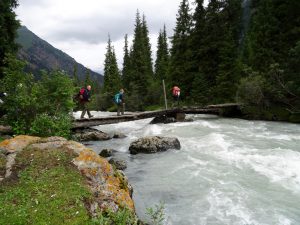 Crossing the river from camp we climbed up through pine forest dripping from the night’s rain. Emerging from the forest the path steepened as we climbed a former terminal moraine. As we did so, thunder began to rattle around over our heads and rain could be seen approaching from across the valley. At this point Mike and I were ahead of the group and, as the rain and hail began to descend upon us we came across a yurt camp. We were invited to shelter in a tent and were quickly joined by a group of Slovenians.
Crossing the river from camp we climbed up through pine forest dripping from the night’s rain. Emerging from the forest the path steepened as we climbed a former terminal moraine. As we did so, thunder began to rattle around over our heads and rain could be seen approaching from across the valley. At this point Mike and I were ahead of the group and, as the rain and hail began to descend upon us we came across a yurt camp. We were invited to shelter in a tent and were quickly joined by a group of Slovenians.
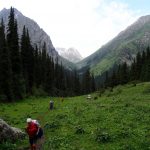
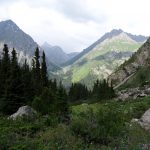
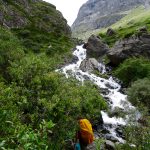 The rest of the group came by as the rain was easing so we tagged on to the back. Alex was not best pleased.
The rest of the group came by as the rain was easing so we tagged on to the back. Alex was not best pleased.
Soon the route became steep again as it climbed up beside the river that flowed out from Lake Ala Kul. It was really impressive.
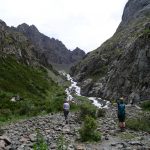
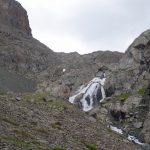
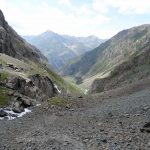 Chris was finding the going tough, so I insisted I carried her rucksack for the final steep third of the route. She immediately started to move more freely and my confidence that she was going to make it grew.
Chris was finding the going tough, so I insisted I carried her rucksack for the final steep third of the route. She immediately started to move more freely and my confidence that she was going to make it grew.
The route took us through a variety of steep terrains until we reached the top. Immediately beneath us was our camp but the view beyond camp was stunning. Before us was a blue/green lake with a wall of craggy mountains of about 4000m rising from it. Wow! And I have that view from my wind battered tent held down with lumps of rock as there is nowhere to put pegs in. This is wild camping at its best and I feel a good night’s sleep is on the cards.
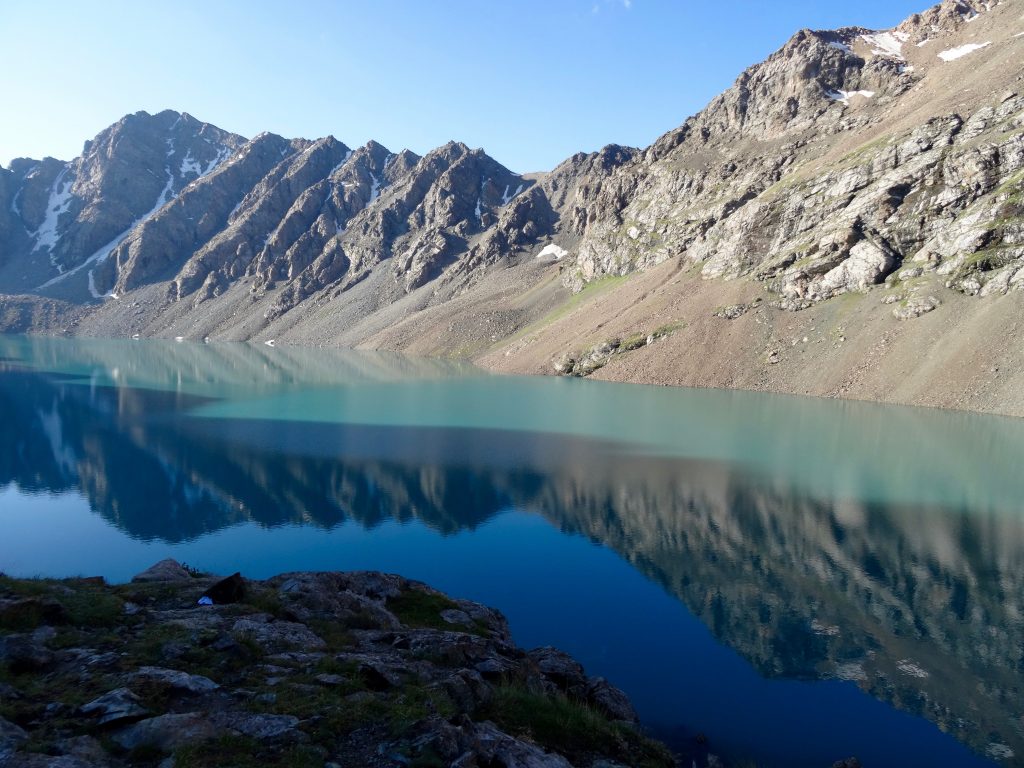 After the best night’s sleep yet a cloudless sky greeted us in the morning. I opened my tent door to look upon the still waters of the lake reflecting the ridge line above the opposite shore. You simply could not tire of such a view.
After the best night’s sleep yet a cloudless sky greeted us in the morning. I opened my tent door to look upon the still waters of the lake reflecting the ridge line above the opposite shore. You simply could not tire of such a view.
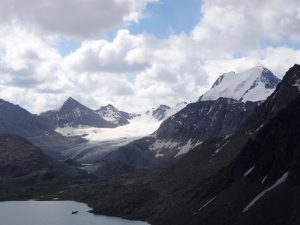 After breakfast we set off on the 500m climb up to the Ala Kul Pass at 3918m, the high point of the trek. It was clear quite early on that Chris was struggling with climbing at altitude, so after a while I insisted on taking her pack from her. I had carried her pack for a good part of each day, making my load about 13kg, not an enormous weight in itself but probably heavier than I have ever carried at altitude.
After breakfast we set off on the 500m climb up to the Ala Kul Pass at 3918m, the high point of the trek. It was clear quite early on that Chris was struggling with climbing at altitude, so after a while I insisted on taking her pack from her. I had carried her pack for a good part of each day, making my load about 13kg, not an enormous weight in itself but probably heavier than I have ever carried at altitude.
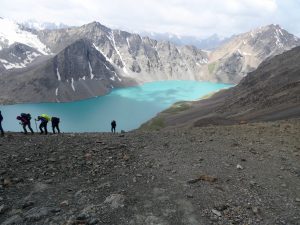 There was quite a bit of stop/start about the climb, which I found very difficult. I needed to set a rhythm and stick to it as long as I could. Having checked with Alex that it was okay to forge ahead, I set out for the top of the pass. I still had about 300m to climb but setting a plod I managed to get there without stopping, other that to stand aside to let quicker walkers pass. It was satisfying to be able to go at my own pace and I felt good. Although I was breathing quite heavily, I did not feel any effects from the altitude.
There was quite a bit of stop/start about the climb, which I found very difficult. I needed to set a rhythm and stick to it as long as I could. Having checked with Alex that it was okay to forge ahead, I set out for the top of the pass. I still had about 300m to climb but setting a plod I managed to get there without stopping, other that to stand aside to let quicker walkers pass. It was satisfying to be able to go at my own pace and I felt good. Although I was breathing quite heavily, I did not feel any effects from the altitude.
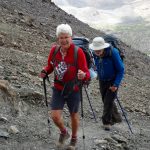
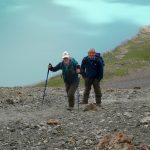
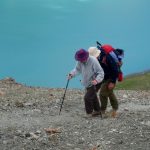 From the top the views either side were spectacular. On the side I had climbed the whole of Lake Ala Kul lay beneath me with its turquoise waters, beyond layered ridges and peaks of rock and snow as far as the eye could see. The top end of the lake is fed from a very short river, the source of which was a glacier clinging to an unnamed sharp peaked mountain of 4233m. On the other side of the pas it was again mountain after mountain as far as the eye could see. My attention was also drawn to the way down, an incredibly steep path of very loose material. That was going to be fun. Initially I hunkered down next to the crest of wind sculptured snow, which gave me some shelter from the light, but cold wind. I didn’t stay there long as I didn’t want to miss the opportunity of greeting the team when they reached the top. I had been on the pass for about half an hour when Alex came with Claire and Terry. Soon after Sandie and Simon appeared, later followed by Mike looking after Chris. Two days ago we thought that Chris wouldn’t make it, that she would have to drop out. Yet here she was, at 3918m on the Ala Kul Pass. It shows a measure of her determination, but I must recognise the help and support she received from the rest of the group, Simon and Mike in particular. I am also grateful to her for giving me the opportunity to push myself. As I get older I begin to question my own capabilities and this has proved to me that I can still visit places of altitude if I put my mind to it. I was fortunate that I did not feel any effects of being at nearly 4000m without any acclimatisation.
From the top the views either side were spectacular. On the side I had climbed the whole of Lake Ala Kul lay beneath me with its turquoise waters, beyond layered ridges and peaks of rock and snow as far as the eye could see. The top end of the lake is fed from a very short river, the source of which was a glacier clinging to an unnamed sharp peaked mountain of 4233m. On the other side of the pas it was again mountain after mountain as far as the eye could see. My attention was also drawn to the way down, an incredibly steep path of very loose material. That was going to be fun. Initially I hunkered down next to the crest of wind sculptured snow, which gave me some shelter from the light, but cold wind. I didn’t stay there long as I didn’t want to miss the opportunity of greeting the team when they reached the top. I had been on the pass for about half an hour when Alex came with Claire and Terry. Soon after Sandie and Simon appeared, later followed by Mike looking after Chris. Two days ago we thought that Chris wouldn’t make it, that she would have to drop out. Yet here she was, at 3918m on the Ala Kul Pass. It shows a measure of her determination, but I must recognise the help and support she received from the rest of the group, Simon and Mike in particular. I am also grateful to her for giving me the opportunity to push myself. As I get older I begin to question my own capabilities and this has proved to me that I can still visit places of altitude if I put my mind to it. I was fortunate that I did not feel any effects of being at nearly 4000m without any acclimatisation.
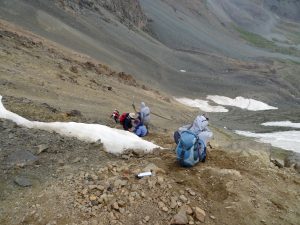 Now we had to get everybody safely down the other side. Some were facing their demons, which clearly had to be overcome. The difficulty was that you had to shuffle yourself into a position where your feet touched the ground, ground that was anything but firm. It was also important to get those who feared it most down first so that they didn’t have time to think about it. Alex and Simon got Sandie over the edge to a point where Simon could capably take over. Alex then came back for Chris.
Now we had to get everybody safely down the other side. Some were facing their demons, which clearly had to be overcome. The difficulty was that you had to shuffle yourself into a position where your feet touched the ground, ground that was anything but firm. It was also important to get those who feared it most down first so that they didn’t have time to think about it. Alex and Simon got Sandie over the edge to a point where Simon could capably take over. Alex then came back for Chris.
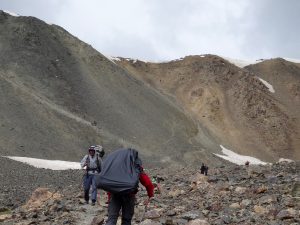 We were fortunate to have a couple of the crew to help get us started. They were really cheerful and both, I discovered, support Chelsea. Unfortunately they had not heard of Lincoln City! Mike was next, then Claire, followed by Terry and I brought up the rear. It was just that initial leap of faith over the edge that was the difficulty. After that it was fun, although you had to concentrate throughout. Everybody made it down safely, although Terry did break a pole in a tumble. Rather that than break himself.
We were fortunate to have a couple of the crew to help get us started. They were really cheerful and both, I discovered, support Chelsea. Unfortunately they had not heard of Lincoln City! Mike was next, then Claire, followed by Terry and I brought up the rear. It was just that initial leap of faith over the edge that was the difficulty. After that it was fun, although you had to concentrate throughout. Everybody made it down safely, although Terry did break a pole in a tumble. Rather that than break himself.
Lunch was quickly taken in a yurt before continuing the lengthy 1400m descent into camp at Altyn-Arashan where a small resort has developed around some hot mineral springs. It was a delight to spend some time luxuriating in the hot water after four days of strenuous activity with little or no facilities.
In the evening, following dinner, we popped along to the resort shop to buy some bottled beer, which they put into a Morrisons plastic bag! How does that happen?
So ends the first phase of this trip. Despite it being only a four-day trek it has been truly amazing. We have feasted our eyes on some truly amazing sights. It is hardly surprising that the Karokol region is so popular, and will become more so when the message is spread that Kyrgyzstan has some mountain scenery to match any in the world. What they have to be very careful about is that they don’t fall behind with the infrastructure. Wild camping is great but when there are no toilet facilities the camping areas can soon lose their attraction.
